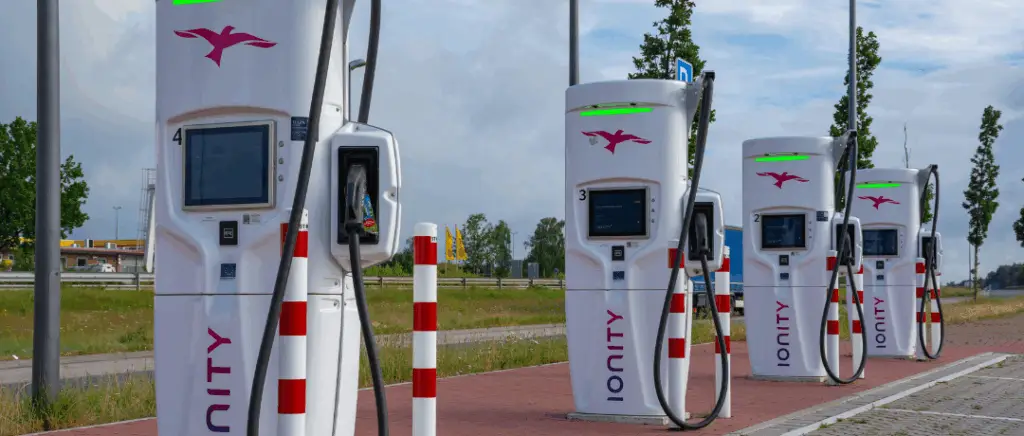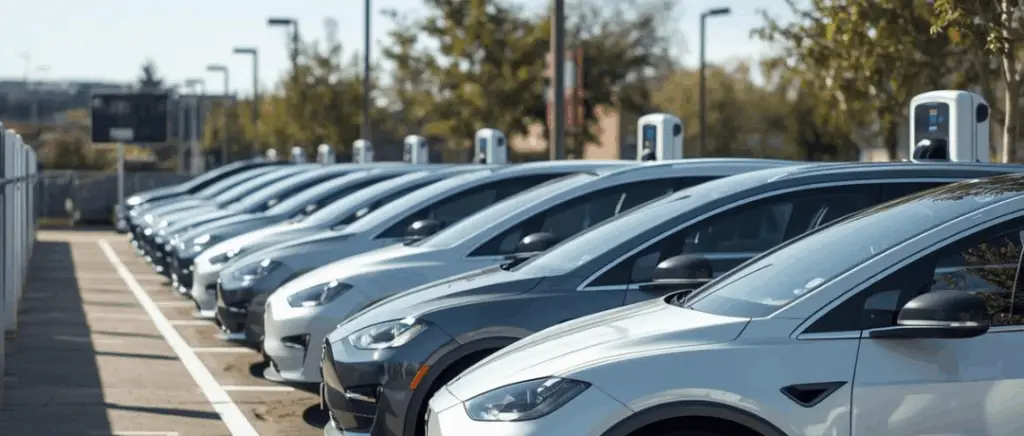1. Plug & Charge charging stations: functional first and foremost
Plug in and charge. It couldn't be simpler, could it? Each charging station combines power electronics, digital communication and intelligent networks to deliver energy reliably and in an optimised way. These infrastructures are becoming key assets for guaranteeing vehicle availability, streamlining operations and maximising the productivity of your staff. electric fleets on a grand scale.
Definition and operation of Plug & Charge stations
Plug & Charge (PnC) is a recharging protocol that allows an electric vehicle to automatically identify itself at a charging station and start recharging without any action on the part of the driver. In practical terms, all the driver has to do is plug the vehicle into the station: the secure communication between the car and the station manages identification, power setting and billing. The driver no longer needs an RFID badge or payment card.
Behind this apparent simplicity lies a sophisticated system: the car and the charging point exchange secure digital signals to identify the vehicle, adjust the charging power and carry out the billing, without any human intervention.
This technology is establishing itself as a standard for businesses and multi-site fleets, where smooth, fast recharging is essential.
Use case: Smart Charging Cube for heavy goods vehicles
For fleets of electric HGVs, MAN Truck & Bus has recently developed the Smart Charging Cube, in partnership with AW Automotive. This solution includes :
- A battery storage capacity of 500 to 1,100 kWh.
- Up to four simultaneous charging points with a maximum power of 400 kW.
- Possible integration of self-generated energy (photovoltaic panels).
- Advanced functions: peak shaving, dynamic power management, bi-directional charging (V2G).
The Smart Charging Cube can be installed in warehouses, workshops or on isolated sites such as building sites, offering a flexible solution to companies subject to severe organisational constraints. It does, however, have a few drawbacks, such as a high price tag on top of the existing infrastructure and an exclusivity clause that makes it (for the time being) only available to MAN customers.
Good to know: A practical alternative to Plug & Charge is the Beev supervision tool. This centralised platform makes it possible to control all recharging from a single dashboard, optimise electricity consumption, plan recharging according to the fleet's needs and analyse data to better control costs and anticipate future requirements. Comfortable for the user and essential for fleet managers, this tool simplifies the day-to-day management of electric fleets.
With Beev
Switch to
Electric cars
or install your
Charging station
For individuals and businesses
2. Ultra-fast terminals: up to 600 kW for every need
The new Alpitronic HYC 1000 charging points have been installed in the Lyon suburb of Bron, in the Novotel car park. They are capable of delivering up to 600 kW of power. Thanks to a 1,000 kW Power Unit spread over 8 charging points, each vehicle can benefit from a maximum power of 125 kW, even when the station is full. This technical feat means that city cars and commercial vehicles can recharge quickly, even when demand is high.
Advances that are shaping the future of recharging
To operate at full capacity, ultra-fast charging stations incorporate cutting-edge technologies:
- Liquid-cooled to maintain optimum performance even under intensive load.
- Intelligent power management to maintain stable performance even when several vehicles are connected simultaneously.
They offer a number of advantages to users:
- Reduced vehicle downtime thanks to ultra-fast recharging.
- Maximum availability of vehicles to meet operational needs.
- Flexibility to charge all types of electric vehicles (city cars, vans or HGVs) on the same site.
Despite their performance, these charging points are often oversized for company sites and involve high costs, both for the power supply and for the deployment of the infrastructure itself. Beev can help you choose and install charging stations with the right power for your fleet. By scheduling charging at off-peak times or according to operational use, dynamically managing the power delivered and centralising control, you can control your costs and anticipate the evolution of your needs down to the last kW.
3. Bollards powered by wind turbines: a step towards the futureautonomy energy
France's first fast-charging station connected directly to wind turbines was recently inaugurated at Breteuil in the Oise department. The site offers up to 400 kW of power for just €0.30/kWh, a very attractive rate compared with the national average for fast-charging stations (around €0.55/kWh).
Ecological and economic advantages
The station relies on five local wind turbines, capable of covering around 80 % of the needs of the four fast charging points installed. When there isn't enough wind, the remainder is supplied by certified renewable electricity from the national grid.
This approach has a number of advantages for users and opens up interesting prospects for companies:
- Energy independence and a significant reduction in operating costs.
- Ideal for isolated sites, logistics zones or multi-site fleets with high electricity consumption.
- Positive impact on brand image: carbon neutrality and stronger environmental commitment.
This type of infrastructure is costly to install and complex to operate, particularly when it comes to ensuring compatibility between wind generation and demand for recharging in real time.
While you wait for it to be perfected, you can turn to solar charging points linked to your photovoltaic installation, combined with an intelligent monitoring tool that will enable you to exploit the potential of smart charging and rationalise your energy costs.
Company terminals: a flexible and profitable investment
These three innovations highlight the growing interest in recharging infrastructures, supported by a European policy favourable to sustainable mobility. They respond to the concerns often expressed by professionals wishing to convert their fleets to electric vehicles: vehicle availability, fast recharging, cost control and energy autonomy.
But while relying exclusively on public charging may seem practical at first, it's rarely a viable solution for a business fleet. Between the unpredictable availability of charging points, queues at peak times and the higher cost per kWh, logistical organisation quickly becomes a headache and a drag on productivity.
An integrated, turnkey infrastructure
Installing charging points directly on site means greater independence: charging can be done at any time, often during off-peak hours, without disrupting team activity. Professional charging stations can power all types of vehicle: company cars for employees, light vans for logistics and even electric HGVs.
Properly chosen and deployed, a recharging infrastructure can optimise vehicle availability while reducing downtime, a strategic asset for intensive fleets.
Savings and short-term amortisation
In addition to the operational aspect, there is a solid economic argument: fast public charging can cost up to twice as much as on-site charging, especially when it is optimised by means of an off-peak electricity contract. The initial investment in charging stations is also lightened by tax measures (accounting depreciation, specific deductions) that accelerate the return on investment.
Finally, owning your own charging points means that you can do more than just provide an in-house service. More and more companies are choosing to monetise their infrastructure by offering charging to employees using their own vehicles, to visitors or to their logistics partners. This is a sensible way of making the installation profitable, while at the same time highlighting the company's commitment to sustainable mobility.
Step-by-step deployment of corporate charging stations
1. Define your needs
The first stage consists of analysing the site and its electricity network: available power, configuration of car parks, number of charge points required today and in the future. The audit also takes into account the fleet's usage profile: company cars, light commercial vehicles, HGVs and visitors.
An accurate audit also enables us to know how many terminals to install immediately and to anticipate future growth in the fleet.
2. Choosing your equipment
It's best to select the right wattage for the job:
- 7 kW is enough for cars parked for several hours or overnight,
- 22 to 50 kW for commercial vehicles running several times a day,
- and fast charging stations, up to 150 or 350 kW, for vehicles that need to get going quickly or that are open to the public.
It's essential to opt for connected terminals: they allow you to control consumption remotely, avoid overloads and easily manage billing.
3. Check regulatory compliance
Installation is often underestimated, even though it makes all the difference to the reliability and security of the system. A poorly installed or wired terminal can cause outages, recurrent breakdowns or even damage the company's internal network.
Using certified IRVE technicians guarantees :
- a precise diagnosis of the site's constraints (soil, cabling, vehicle access),
- installation that complies with electrical and safety standards,
- optimised grid connection, limiting losses and the risk of overloading,
- and above all, rapid commissioning without disrupting the site's day-to-day operations.
A good installation also means that upgradable functions can be incorporated from the outset, such as centralised supervision, automatic pricing and even two-way charging (V2G) for more advanced fleets.
4. Deploying infrastructure on site
Rather than installing all the charging points at once, it is often preferable to proceed in stages: starting with priority areas (commercial vehicles or vehicles in frequent rotation), then extending the network as the fleet grows.
This strategy avoids tying up too much capital and allows the infrastructure to be adapted to the actual pace of business.
5. Monitoring and monetisation tools
Once the charging points are in place, an intelligent supervision tool becomes essential to schedule off-peak charging, monitor consumption in real time and limit power peaks.
Some companies also choose to monetise access to the charging points: employees, visitors or partners can recharge on the spot, with automatic billing.
Electric mobility is no longer simply a question of image: it has become a competitive advantage for companies wishing to reduce their operating costs and anticipate future European regulations. The latest innovations prove that the technology is ready to support intensive fleet use.
However, the success of a recharging project is not limited to the choice of a charging point: it depends on intelligent sizing, compliant installation and precise monitoring of consumption. This is where Beev comes in: from the initial audit to the deployment and supervision of the charging points, our teams guarantee that your vehicles will always be available, that costs will be kept under control and that the energy transition will be smooth and efficient.
By investing in on-site infrastructure today, you can free yourself from the constraints of public charging and gain greater autonomy, efficiency and competitiveness.
































